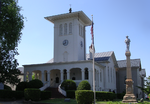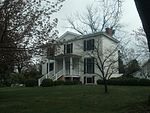Williston (Orange, Virginia)
Central Virginia Registered Historic Place stubsFarms on the National Register of Historic Places in VirginiaHouses completed in 1867Houses in Orange County, VirginiaHouses on the National Register of Historic Places in Virginia ... and 2 more
Italianate architecture in VirginiaNational Register of Historic Places in Orange County, Virginia

Williston is a historic home and farm complex located near Orange, Orange County, Virginia. It was built in 1867, and is a two-story, three-bay, Italianate style brick dwelling. The front facade features a tall portico with paired fluted polygonal columns set on pedestals. The interior features stenciled and painted murals on the dining room walls. Also on the property are the contributing smokehouse, hen house, servant's house, carriage house, granary and the foundation and lean-to of what was formerly a late-19th century barn.It was listed on the National Register of Historic Places in 2005.
Excerpt from the Wikipedia article Williston (Orange, Virginia) (License: CC BY-SA 3.0, Authors, Images).Williston (Orange, Virginia)
Baylor Lane,
Geographical coordinates (GPS) Address Nearby Places Show on map
Geographical coordinates (GPS)
| Latitude | Longitude |
|---|---|
| N 38.239722222222 ° | E -78.135277777778 ° |
Address
Baylor Lane 12102
22960
Virginia, United States
Open on Google Maps










